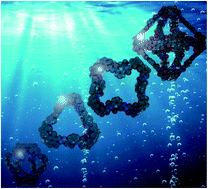Water-stable hydrazone-linked porous organic cages†
Abstract
Although porous organic cages (POCs), particularly imine-linked (C![[double bond, length as m-dash]](https://www.rsc.org/images/entities/char_e001.gif) N) ones, have advanced significantly over the last few decades, the reversible nature of imine linkages makes them prone to hydrolysis and structural collapse, severely limiting their applications under moist or water conditions. Herein, seven water-stable hydrazone-linked (C
N) ones, have advanced significantly over the last few decades, the reversible nature of imine linkages makes them prone to hydrolysis and structural collapse, severely limiting their applications under moist or water conditions. Herein, seven water-stable hydrazone-linked (C![[double bond, length as m-dash]](https://www.rsc.org/images/entities/char_e001.gif) N–N) POCs are prepared through a simple coupling of the same supramolecular tetraformylresorcin[4]arene cavitand with different dihydrazide linkers. Their structures are all determined by single-crystal X-ray crystallography, demonstrating rich structural diversity from the [2 + 4] lantern, [3 + 6] triangular prism, and unprecedented [4 + 8] square prism to the extra-large [6 + 12] octahedron. In addition, they respectively exhibit tunable window diameters and cavity volumes ranging from about 5.4 to 11.1 nm and 580 to 6800 Å3. Moreover, their application in the water environment for pollutant removal was explored, indicating that they can effectively eliminate various types of contaminants from water, including radionuclide waste, toxic heavy metal ions, and organic micropollutants. This work demonstrates a convenient method for rationally constructing versatile robust POCs and presents their great application potentialities in water medium.
N–N) POCs are prepared through a simple coupling of the same supramolecular tetraformylresorcin[4]arene cavitand with different dihydrazide linkers. Their structures are all determined by single-crystal X-ray crystallography, demonstrating rich structural diversity from the [2 + 4] lantern, [3 + 6] triangular prism, and unprecedented [4 + 8] square prism to the extra-large [6 + 12] octahedron. In addition, they respectively exhibit tunable window diameters and cavity volumes ranging from about 5.4 to 11.1 nm and 580 to 6800 Å3. Moreover, their application in the water environment for pollutant removal was explored, indicating that they can effectively eliminate various types of contaminants from water, including radionuclide waste, toxic heavy metal ions, and organic micropollutants. This work demonstrates a convenient method for rationally constructing versatile robust POCs and presents their great application potentialities in water medium.

- This article is part of the themed collections: Materials & Energy in Chemical Science - most popular articles 2021 and In celebration of Chinese New Year, 2022


 Please wait while we load your content...
Please wait while we load your content...